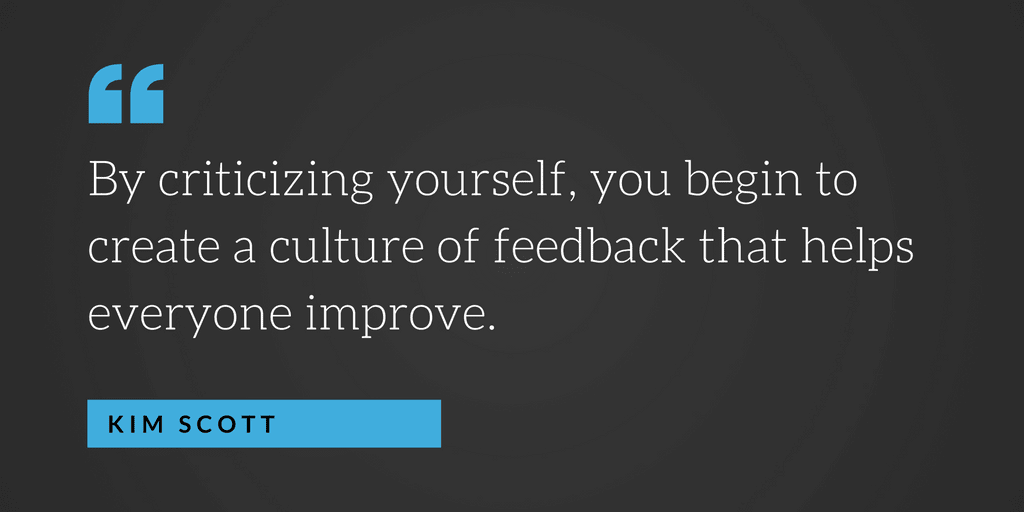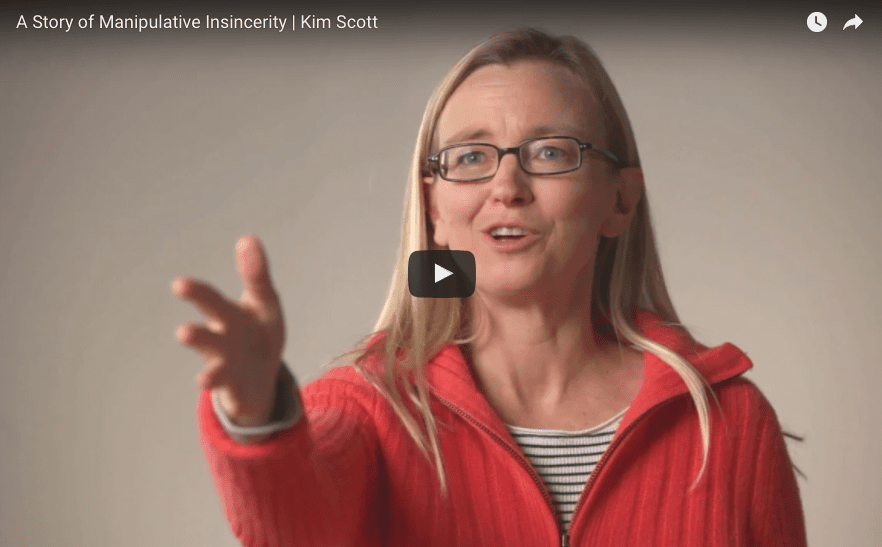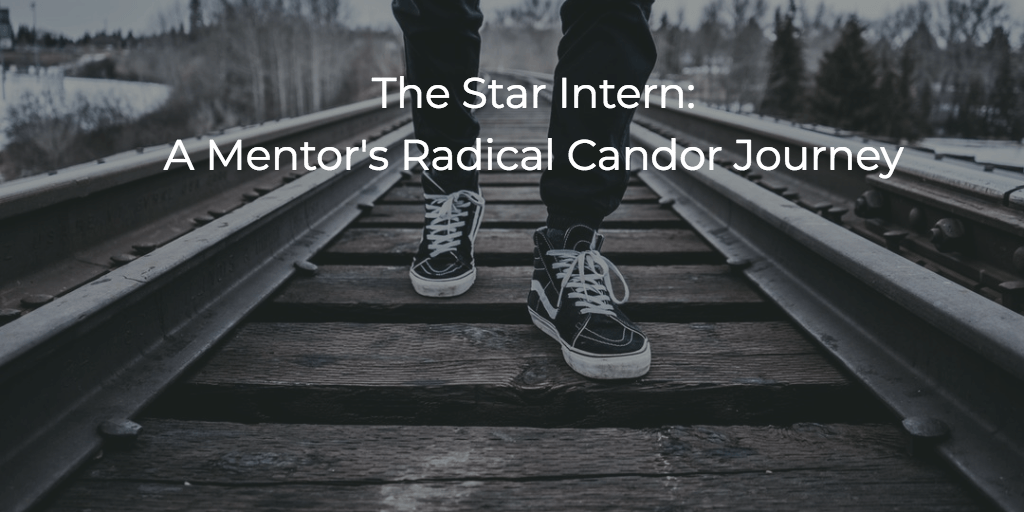Video: Kim's Manipulative Insincerity Story
Remember that the labels that we use for the Radical Candor framework (Radical Candor, Ruinous Empathy, Obnoxious Aggression, Manipulative...

Two of my goals in starting Candor, Inc. and also in writing Radical Candor are to help others learn from my mistakes, and to encourage leaders to be open about the mistakes they make. There are several benefits to being self-critical publicly. One, you show that you know you’re not perfect, and this encourages others to criticize you when you’re making mistakes you may not be aware of. Two, you show that it’s not the end of the world to make a mistake or to be wrong. This encourages the kind of risk-taking that is essential for innovation. Three, by criticizing yourself, you begin to create a culture of feedback that helps everyone improve.
This kind of self-criticism is the goal of a great technique I learned about from Dan Woods when we worked together at Capital Thinking in 1999 (!) called Whoops-a-Daisy. We introduced the idea of Whoops-a-Daisy in our article about encouraging feedback between the people on your team, but I’ll explain it again briefly here.

Bring a stuffed daisy flower to your next team meeting. (Works well at a small team, though it works with up to 100 people too, I’ve found.) Then, ask people to stand up and share a mistake they’ve made in the past week. Let them know that anyone who tells a story gets instant and automatic forgiveness. And the person who tells the best story, as measured by loudness of applause, wins “Whoops” for a week.
Starting this process and getting people comfortable with sharing their mistakes is extremely valuable for creating a culture of feedback and learning.
The first time you try this, you’ll need three things:

To help you understand what I mean by a story of your own, I thought I’d share my biggest Whoops of 2016. Here’s my story:
I could have hired Howie Fung, who now leads product at Candor, fully six months before I did. And if I had, not only would we have made faster progress on the Candor Coach, the whole team would have been happier. It’s so obvious in retrospect that I should have given Howie an offer as soon as I met him that it’s embarrassing I didn’t. But the biggest mistakes we make are often obvious, often painfully obvious, to those around us.
The interesting thing about this mistake is that, not only did my whole board tell me I should hire Howie right away, but feedback I’d gotten over and over throughout my entire career could have helped me avoid screwing up if only I’d been listening better. At pretty much every job I’ve had since 1999 people have told me I am not a product person. So when I set out to turn a management philosophy into a product, the very first thing I should have done was to hire a great product person. And yet I didn’t…
Why did I not know what was obvious to those who knew me well: that I am not a product person. Why did I not know that if I wanted to translate my vision into a reality I would frustrate the hell out of the engineers I was working with unless I had a great product person?
The first person to tell me I was not a product person was Brad Felix. This was 2000, and I’d recently started a software company. Brad told me we needed a Product person. He found Jared Smith’s resume on Monster.com. In an interview Jared Smith explained to me what a Product Manager did; I still didn’t understand what product management was or why we needed it, but I liked Jared a lot, so I hired him. Jared too told me I wasn’t a product person.
After that, Jared and I went to Google in California, where Susan Wojcicki told me I was not a product person. Like Brad’s and Jared’s, Susan’s words lingered somewhere in my consciousness — Kim, you are not a product person — but didn’t fully penetrate.
Then, when Russ and I started Candor, Inc, I explained to two great engineers, Andrew Catton and Ben Matasar, that I knew exactly what we needed to build, and that I just needed a few engineers to sit and build it with me. Andrew said, “I have never seen a great product get built that way. But I love what you are trying to do, so I hope you are right!”
My husband then joined the chorus, warning me that I am not a product person. The next voice was that of Shona Brown, who chairs our board. She suggested I consider hiring a product person. “But I know what we need to build!” I exclaimed. She laughed. “If you listen to half my advice I’m batting above average as your advisor.” Freud says there is knowing without knowing. I knew I should listen to Shona without quite knowing it. To convince her, or myself, or both of us that I had taken to heart what she said, I interviewed a few product people, including Howie Fung.
Howie was the perfect person to lead product at Candor. He’d led product at WikiMedia and then built an app to help improve the way that people give feedback to each other. But here comes the ‘without knowing’ part of knowing without knowing. I didn’t make Howie an offer because I’d decided that I could lead product for us. Howie, during an interview, gently suggested that a book is not a product requirements document. “Of course, of course!” I agreed. I knew on one level he was right. But at another level, I didn’t know. “It’s too early for us to hire somebody to lead product,” I told myself, and Howie. “I just need to sit with our engineers and crank the early prototype out.”
Once again, knowing without knowing.
Wrong! That we needed a product leader was obvious to to others, but still not to me.
It was into this fertile ground that some criticism from our investors at Homebrew, Hunter Walk’s and Satya Patel, fell. I was proudly showing Satya a prototype of what we were building and he told me, “I get what you are doing, and I’m more excited than ever by it. But you’d get much further faster with a great product person!”
Satya’s words hit their target. His words ringing in my ears, I called up Howie Fung again, told him I’d made a terrible mistake not making him an offer the first time I met him, and begged him to join Candor. Luckily he did. I owe him, big time.
And I owe Satya, too. And all the other people who’ve told me I’m “not a product person” over the years. Giving Satya all the credit for helping me see the error of my ways is a little bit like ignoring view through conversions and paying attention only to that last click :) It was thanks to not just to Satya Patel, but also to Hunter Walk, Shona Brown, Andy Scott, Andrew Catton, Ben Matasar, Susan Wojcicki, Jared Smith, and Brad Felix--and probably also to a dozen others whose feedback I’m not remembering consciously right now, that I finally picked up the phone and called Howie.
The progress our engineers have been able to make in just a few short weeks since Howie started has been nothing short of remarkable. Sometimes, when you find just the right person to collaborate with, it’s like getting a mental prosthesis. You’ve been having ideas that feel clear to you but, frustratingly, you can’t explain them correctly to others. Then you meet your mental prosthesis, and this person can translate. Not only can the person translate, the person adds ideas that are better than anything you’ve thought of before.
When Howie started, it was like getting such a mental prosthesis. Suddenly, we were all moving much faster than we had been before. Howie challenged the way we’d been thinking, and that made a big difference to the product. He also is a supportive colleague who cares about each person he works with. He’s had a huge impact on the happiness of everyone on the team. The engineers report feeling both much happier and more focused than they were before he joined. I have started sleeping again; personally, I am a lot happier. If I had really and truly listened to the feedback I was getting in interviews, in the boardroom, and even in the bedroom, and then acted on it you’d already be using the Candor Coach, you wouldn’t have to wait till March!
Thank you to all the good people who gave me good feedback along the way. And thank you Howie for joining us even though I didn’t move as fast as I should have! 2017 is officially going to be the year not just of Radical Candor (the idea that changes your thinking about management), but of Candor Coach (the Product that will help you change your behavior)! I am so excited to unveil the Candor Coach we are building to you in March.
In the meantime, though, try to avoid my mistake! Do a better job hearing feedback faster than I did.
We’d like invite you to think back on 2016 and share your Whoops stories with us here at Candor. We will read them and give you pointers for improving them before you take them to your team.

Remember that the labels that we use for the Radical Candor framework (Radical Candor, Ruinous Empathy, Obnoxious Aggression, Manipulative...

We recently heard from Dimitar Simeonov, who shared his story about reading Radical Candor while managing an intern when he was working at Twitter as...

Kim Scott is the author of Radical Candor: Be a Kick-Ass Boss Without Losing Your Humanity and Radical Respect: How to Work Together Better and...